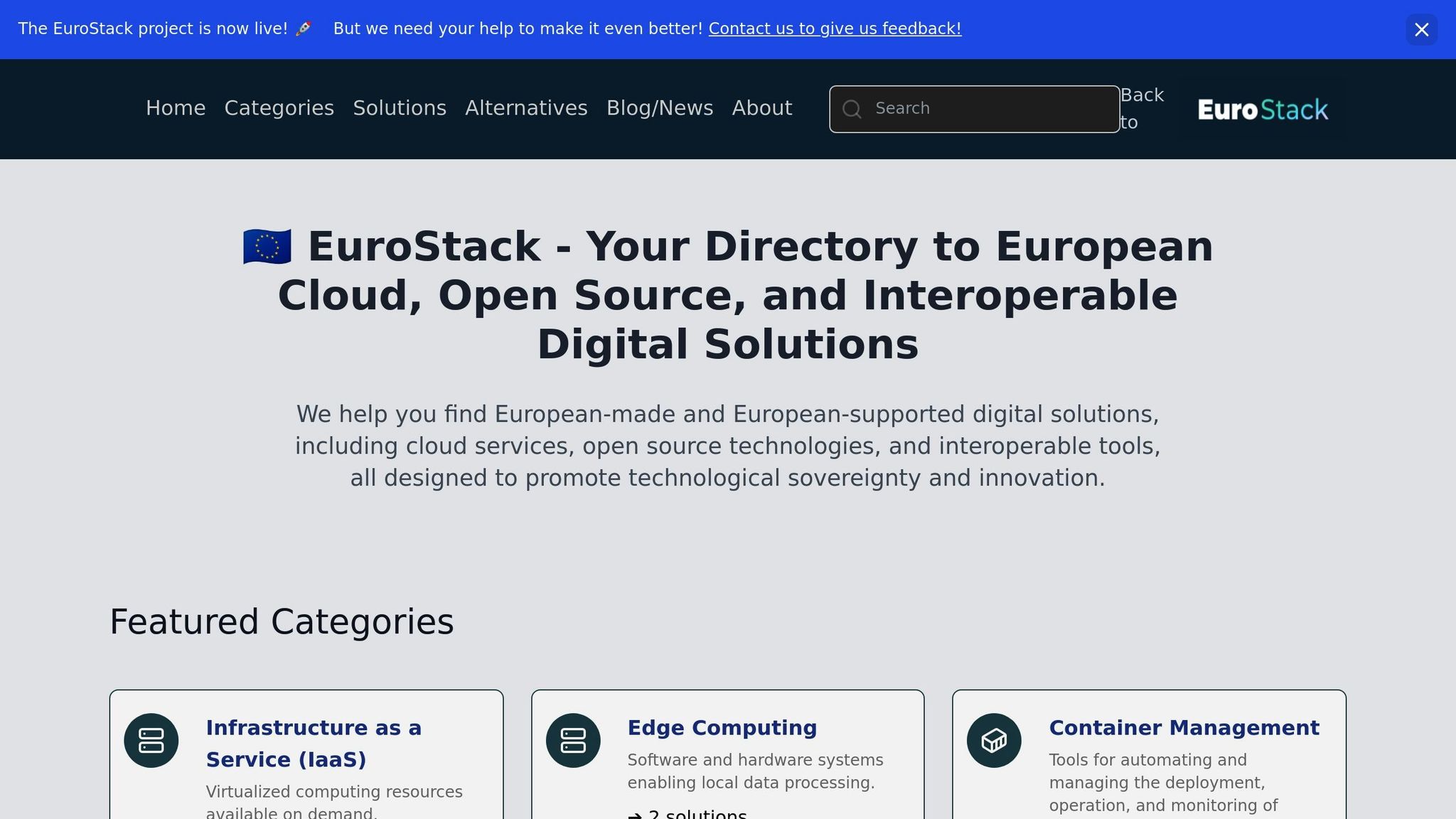China’s New ESG Reporting Requirements from 2026: What European Companies Need to Know
China's introduction of comprehensive ESG regulations represents a watershed moment for global...
By: Johannes Fiegenbaum on 7/29/25 11:47 AM

EuroStack is an initiative that strengthens Europe’s digital sovereignty by building an independent, European technology infrastructure. The goal is to reduce dependency on non-European providers and help companies better manage regulatory, operational, and climate-related risks. This movement aligns with the European Union’s broader ambitions for digital autonomy, as outlined in the European Strategy for Data, which seeks to empower businesses and citizens while ensuring data remains under European control.

Conclusion: EuroStack is the key to an independent, secure, and future-proof digital infrastructure in Europe. It allows you to minimize risks, ensure compliance, and strengthen your competitiveness at the same time.
EuroStack is based on eight strategic technology areas – from semiconductors and cloud computing to AI and quantum technology. Together, they form the foundation for an independent digital infrastructure in Europe. For example, the Once-Only Technical System (OOTS) enables authentic documents like birth certificates to be accessible across EU borders, illustrating the importance of seamless interoperability. The EU’s European Cloud Federation further exemplifies efforts to create a unified digital backbone that reduces fragmentation and boosts resilience.
The SECA standard ensures that companies are not locked into individual providers. This approach enables greater flexibility and improves geographic scalability through federated cloud concepts. European cloud providers can utilize each other’s data centers to expand capacity and extend their reach, as promoted by the Gaia-X initiative—a flagship project for secure, federated data infrastructure in Europe.
The DIGITAL Building Blocks program from the European Commission offers EU-owned solutions that are secure, interoperable, and universally deployable. These standards also lay the foundation for applications that are not only effective but also environmentally friendly—a topic explored in the next section.
Sustainability is a central element of EuroStack. Companies can use it to implement ESG requirements and comply with the EU Taxonomy. This taxonomy defines six environmental objectives that promote sustainable economic activities (EU Taxonomy for Sustainable Activities).
In the area of climate protection, EuroStack helps reduce greenhouse gas emissions and increase resilience to climate risks. This includes the use of renewable energy and higher energy efficiency. The circular economy is also supported: with EuroStack technologies, waste can be reduced, recycling processes improved, and resources used more efficiently. According to McKinsey, digital solutions can enable up to 20% of the EU’s targeted emissions reductions by 2030, making such infrastructure pivotal for sustainability.
A real-world example: Markus, an automotive manufacturer from Munich, uses EuroStack technologies to optimize his production. In collaboration with a Dutch supplier, his factory is connected to the EuroStack Decentralized Cloud. Federated AI analyzes data from various EU factories to minimize waste and energy consumption.
Compliance with the EU Taxonomy became significantly easier in 2026. The European Commission reduced the number of required data points in reporting templates for non-financial companies by 64%. This simplification makes it easier for German companies to successfully implement EuroStack solutions.
European regulations are becoming increasingly complex—especially the CSRD (Corporate Sustainability Reporting Directive) and the EU Taxonomy present significant challenges for German companies. With the CSRD, the number of companies required to report in Europe rises from 12,000 to 50,000 (EY). For many German SMEs and large enterprises, this means they will have to prepare comprehensive sustainability reports in the future.
EuroStack offers a solution to meet the requirements of the CSRD and the EU Taxonomy. The platform enables efficient data collection and processing in European data centers. The European Commission has reduced the number of required data points in taxonomy reporting templates for non-financial companies by 64%. With EuroStack’s tools, these simplified processes can be automated, making reporting much easier.
Jozef Síkela, Czech Minister of Industry and Trade, emphasizes the importance of the new regulations:
"The new rules will make businesses more accountable for their impact on society and will guide them towards an economy that benefits people and the environment. Data about the environmental and societal footprint would be publicly available to anyone interested in this footprint."
In addition to managing regulatory requirements, EuroStack also helps reduce technical dependencies and operational uncertainties.
Increasing dependence on foreign technologies poses significant risks. Over 80% of technologies used in Europe are imported, and US providers dominate nearly 70% of the European cloud computing market (Statista). Additionally, around 70% of AI foundation models used worldwide originate from the USA (Oxford Insights).
EuroStack focuses on digital sovereignty to minimize these dependencies. Data from German companies is stored and processed exclusively within national borders, protecting it from extraterritorial laws. At the same time, the platform uses open standards and APIs that enable provider switching, federation, and repatriation to in-house cloud environments.
Andrea Renda, Director of Research at the Centre for European Policy Studies (CEPS), issues a clear warning:
"European leaders are slowly realizing that our industrial future, as well as our democracy and social cohesion, increasingly depends on Europe's ability to rely on a trustworthy technology stack, ranging from compute infrastructure to digital identity, cloud and data."
The German government currently invests only 0.5% of its budget in open-source solutions (Open Source Observatory). EuroStack could fill this gap and offer German companies a trustworthy alternative. The Sovereign Cloud Stack (SCS) also ensures interoperability between different cloud providers, fostering flexibility and independence.
But beyond technical and operational risks, companies must also actively address their climate risks.
The effects of climate change could lead to a GDP decline of up to 25% in some regions by 2050 (The Economist). At the same time, ESG scandals (environmental, social, and governance) can reduce a company’s revenue by 5–10% for at least six months. Overall, S&P 500 companies lost more than $600 billion in market capitalization due to ESG controversies (MSCI).
EuroStack supports companies in implementing the EU Taxonomy and helps minimize climate risks. The platform enables emission tracking, increases energy efficiency, and helps achieve ESG goals. By integrating European sustainability standards, companies can better assess their risks and take targeted action.
The consequences of ESG failures are often severe: The "Dieselgate" scandal cost Volkswagen over $30 billion in 2015. Facebook was fined $5 billion in 2019, and Seagate Technology paid $300 million in 2023 for violations of export control regulations (Reuters).
With EuroStack technologies, companies can identify and manage such risks early on. The platform makes it easier to implement the EU Taxonomy for green investments and opens access to sustainable financing sources while helping to reduce climate risks.
Now that we’ve shown how EuroStack reduces risks, let’s look at how you can practically implement the solution in Germany.
Before introducing EuroStack in your company, you should first conduct a thorough analysis of your existing digital infrastructure. Currently, about 80% of critical digital technologies come from non-EU countries—a dependency factor that should not be underestimated (ECIPE). A detailed assessment helps you identify vulnerabilities and plan necessary steps.
Start with a comprehensive inventory of all software solutions and cloud services in use. Pay special attention to proprietary systems that could lock you into specific providers. Define clear criteria for European providers, such as company headquarters, location of research and development, and compliance with European laws.
A fragmented IT infrastructure can hinder scalability and cross-border collaboration. Check whether your systems support open standards and APIs that make it easier to switch providers later. Also, ensure that sensitive data is stored and processed exclusively within Germany. This analysis forms the basis for working with experts to plan your next steps.
Switching to EuroStack brings some challenges that often require specialized expertise. External consultants like Fiegenbaum Solutions can assist here. They help integrate EuroStack technologies smoothly while ensuring compliance with local and EU regulations such as the CSRD or EU Taxonomy.
A special focus is on leveraging ESG criteria (environmental, social, and governance) as a strategic advantage. Working with trusted European digital providers can help you achieve your sustainability goals more effectively. Consultants train your teams on CSRD-ESG disclosure requirements and mandatory ESRS reporting standards.
Financial incentives such as tax breaks for switching to European providers should also be part of your planning. Experts can help you identify funding opportunities and submit the necessary applications. They also assist in selecting and implementing suitable ESG reporting software to make data collection and reporting more efficient.
The European Union offers numerous funding programs to support German companies in their digital transformation. The Digital Europe Programme has a total budget of more than €8.1 billion and focuses on areas such as supercomputing, artificial intelligence, cybersecurity, and digital skills.
Additionally, Horizon Europe provides over €95 billion for the period 2021–2027, with around 36% of funds earmarked for digital priorities. About €1.6 billion is specifically allocated to projects for the development and use of artificial intelligence.
In June 2025, €145.5 million was provided by the EU to strengthen cybersecurity, and in April 2025, the Commission invested another €140 million in key digital technologies. The Technical Support Instrument (TSI) also offers tailored technical support for implementing digital reforms (TSI).
At the national level, the Federal Ministry for Economic Affairs and Climate Action complements these measures with programs such as the High-Tech Start-up Fund (HTGF), which specifically supports start-ups. By combining national and European funding opportunities, German companies can financially secure their EuroStack implementation while benefiting from the latest technologies.
EuroStack combines digital autonomy with sustainable business development, creating a solid foundation for the competitiveness of German companies in a changing regulatory environment.
Regulatory Security as a Driver of Growth
Political support for EuroStack is steadily increasing: In February 2025, “EuroStack” was explicitly anchored as a model for sovereign cloud and software solutions in Germany’s new coalition agreement. France and the Netherlands are also increasingly relying on domestic alternatives (Politico). This unified European approach provides companies with a stable regulatory framework that encourages investment and innovation.
Financial Benefits and Lower Risk
With EuroStack, German companies can reduce their dependence on US services—currently, €264 billion flows to the USA each year (Financial Times). At the same time, they benefit from European funding programs. This is especially relevant for around 15,000 German companies subject to the expanded CSRD reporting requirements. EuroStack solutions meet European ESG standards and help minimize compliance risks.
Strategic Independence as the Path to the Future
In addition to economic benefits, EuroStack also offers strategic independence that ensures long-term success. It stands for Europe’s vision of digital transformation based on shared values. Francesca Bria, Fellow at the Mercator Foundation, sums it up:
"EuroStack is our moonshot – the digital evolution of the euro and Single Market. EuroStack isn't optional – it's how Europe innovates in the public interest and leads on its own terms."
For German companies, this means: Investing in EuroStack today secures a position in a future built on European values, data protection, and sustainability. The combination of political support, financial benefits, and regulatory clarity makes EuroStack a strategic choice for companies aiming for long-term success.
EuroStack stands for digital autonomy, regulatory security, and sustainable growth—three essential building blocks that are closely linked in today’s business world.
EuroStack helps companies efficiently meet the requirements of the EU Taxonomy and the Corporate Sustainability Reporting Directive (CSRD). With standardized reporting formats and optimized data management, the solution provides exactly what is needed for European sustainability requirements. For more on the CSRD’s impact, see EY’s analysis.
By using EuroStack, sustainability reports can be created much more easily. At the same time, regulatory risks are reduced and compliance with EU regulations is ensured. This not only strengthens transparency but also makes it easier for you to seamlessly integrate ESG criteria into your day-to-day business.
EuroStack is specifically designed to meet European standards and regulations such as ESG guidelines, the CSRD, and the EU Taxonomy. This helps companies achieve their sustainability goals while complying with legal requirements. The EU Taxonomy provides a clear framework for what counts as sustainable, ensuring that investments and operations align with the EU’s climate ambitions.
A key feature of EuroStack is its consideration of regional circumstances. This strengthens data sovereignty and reduces dependence on global providers, who are often less regulated. As a result, not only is sustainable development promoted, but innovation within Europe is also strengthened.
German companies can easily integrate EuroStack into their digital infrastructure by gradually switching to technologies from Europe. Start with core areas such as cloud services, artificial intelligence, and digital platforms. This ensures your systems meet European data protection and security requirements (GDPR).
By using open standards and open-source software, you create high flexibility and interoperability. This not only makes integration easier but also reduces your long-term dependence on individual providers. In addition, you can benefit from European initiatives and funding programs that facilitate the transition while keeping costs in check.
A step-by-step approach minimizes risks and enables you to efficiently supplement or replace existing systems with European solutions. This not only strengthens your digital independence but also ensures you meet regulatory requirements securely.

ESG & sustainability consultant specializing in CSRD, VSME, and climate risk analysis. 300+ projects for companies like Commerzbank, UBS, and Allianz.
More aboutChina's introduction of comprehensive ESG regulations represents a watershed moment for global...
Looking to navigate the complex landscape of European sustainability reporting? This introductory...